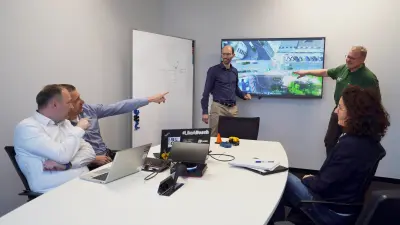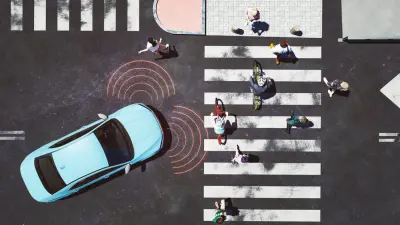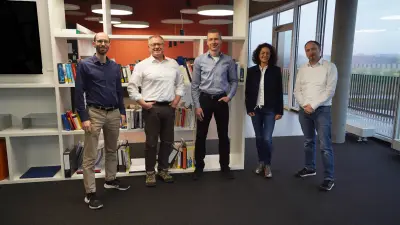Consistently calculated – accident research at Bosch Research
Roads allow us to get from A to B, discover new places, and connect with other people. But with this freedom comes danger. In the exciting world of accident research, companies like Bosch play a crucial role.

From analyzing the causes of accidents to developing innovative safety technologies – the experts at Bosch are doing everything they can to continuously improve the traffic system and prevent accidents. Not only the causes of accidents are investigated, but also the effects on those involved and the environment.
But how exactly does this research work? What methods are used and what challenges must be overcome? We take a look behind the scenes at Bosch Accident Research and find out why their work is so important in making our roads safer.
For almost 20 years, Bosch Accident Research has been a driving force in this field, working to improve road safety worldwide. The goal is clear: preventing accidents, reducing injuries and saving lives. Bosch Accident Research analyzes accident data, identifies risk factors and derives preventive measures from its findings. Bosch uses these findings to develop innovative technologies and improve existing vehicle safety systems. This makes it possible to raise not only current but also future safety standards in road traffic.
But Bosch Accident Research goes a few steps further. The team also supports the product strategy of the Bosch divisions, the development of sensors and systems, assesses their efficiency and evaluates their effectiveness in the field. Accident Research also contributes to quality management by being able to carry out analyses to assess the severity of accidents as a neutral body. As Bosch is broadly positioned in the mobility sector, the field of accident research covers various types of vehicles, from pedelecs to motorcycles, cars and goods road transport vehicles to trams. And that worldwide.
In recent years, Bosch Accident Research has expanded its focus and now analyzes not only traffic accidents in detail, but also road traffic in general. The interdisciplinary Bosch research team uses traffic observation data to derive valuable insights. This continuously improves the safety of vehicles and other road users in all traffic situations.
Data: The cornerstone of accident prevention

“What we need most urgently in accident research and traffic analysis is a valid and in-depth database,” emphasizes Thomas Lich, head of global accident research and traffic analysis at Bosch. Bosch Accident Research is based on an extensive database that includes a wide variety of sources. Official statistics that provide information on accidents and traffic events are an important source of data. They provide an overview of accident figures, in some cases also of the causes of accidents and the general development of traffic. This allows accident and traffic trends to be observed at national and regional level, but they are limited in their depth of detail.
Accident databases are of crucial importance for comprehensive research, as they contain detailed information. One example of this is the GIDAS project (German In-Depth Accident Study), which celebrates its 25th anniversary in 2024 and is virtually unique worldwide. The Research Association of Automotive Technology (FAT) is funding the project together with the Federal Highway Research Institute at three locations in Germany. As a member of the FAT, Bosch has access to this data. The accident database available to Bosch Accident Research covers 47,000 road accidents with personal injury in Germany. With around 2,000 accidents per year and over 3,500 individual pieces of information per accident, this extensive database forms the foundation for detailed analyses and findings.
In addition to accidents involving personal injury, Bosch Accident Research is also increasingly focusing on accidents involving material damage. These types of accidents, in which there are no injuries, are of interest because they sometimes have different causes, processes and damage patterns. A comprehensive analysis of these accidents is important in order to better understand the overall accident situation and to develop further measures to prevent accidents, especially when parking and maneuvering. As a considerable proportion of these types of accidents are not officially documented, the Bosch Accident Research team is currently working on a cooperation with a major German insurance company in order to open up another valuable source of data for Bosch.
On the road worldwide: Insights into accidents in Asia

The many years of experience of the Bosch Accident Research team serve as a model for other countries around the world. Bosch Accident Research is active worldwide and works closely with international authorities, institutes and universities. This enables the exchange of best practices across national borders. Accident prevention measures can also be adapted to regional needs. The research findings and recommendations of Bosch Accident Research are put into practice together with local partners. This regional focus of Bosch accident research not only has a positive impact on road safety, but also contributes to the sales of the Bosch business units and product divisions.
The Bosch Accident Research team is currently working on another project in Thailand: Together with the Central Institute of Forensic Science, Thailand, an accident database is being set up in Thailand, similar to the GIDAS database that exists in Germany. The project focuses on the detailed documentation and analysis of fatal accidents. This data is integrated into the specially developed Thai accident database TIDAS (Thailand In-Depth Accident Science). The aim is then to derive measures to increase road safety for Thailand.
The TIDAS project incorporates valuable findings from similar international initiatives that the team has been able to establish with its international partners in other countries such as India, China and Brazil over the past two decades.
From accident research to even better assistance systems

Since 2016, accident research has also been increasingly using data from traffic observations, such as drone footage. An external service provider is commissioned to collect data at nodes previously identified as critical, so-called hot spots. Among other things, drones are used to capture a bird’s eye view of traffic situations at a location. This data provides information about traffic patterns, traffic flows and the behavior of road users. They enable a detailed analysis of the traffic situation and infrastructure and help to identify risk factors and potentially dangerous locations. This way, in combination with accident data, vehicle safety and assistance functions can be evaluated and automated driving functions can be validated and further developed.
One example of this is the new radar-based assistance function Adaptive Distance Control (ADC), which is expected to go into series production with a pilot customer in 2026. This function adaptively adjusts the distance to vehicles in front and thus reduces the risk of rear-end collisions, both in dense city traffic and at higher speeds and driving dynamics. During the development of this system, data from traffic observation was analyzed and simulated for the first time in addition to accident data. This has proven to increase both safety and comfort. The publication of the research results led, among other things, to the consumer protection test Euro NCAP becoming aware of this and now examining whether and how this functionality can be included in its test program in the future.
Safe on two wheels – accident investigations for pedelecs

With the increasing popularity of pedelecs, the analysis of accidents involving e-bikes is becoming more and more important. Since 2012, the team has set itself the task of investigating the causes and patterns behind accidents involving e-bikes and pedelecs. The accident researchers not only focus on the accidents themselves, but also look at the behavior of the riders and the effectiveness of safety systems such as the pedelec anti-lock braking system (ABS).
In addition to analyzing existing security systems, researchers are currently focusing on the topic of connectivity. Future functions should not only improve driver safety, but also enable connections with other road users. Connectivity technologies enable the development of potential solutions that further reduce the risk of accidents, especially at intersections, through communication between pedelecs, cars and other road users. Connectivity as a solution approach opens up new perspectives to further increase the safety of pedelec users and other road users and to exploit the full potential of this innovative technology.
Since its foundation over 20 years ago, the results of Bosch Accident Research have provided many impulses for greater road safety worldwide.
To ensure the safety of all road users, researchers are working intensively on new research tasks in view of the current development of electrified, automated and networked vehicles of all kinds. The results of Bosch Accident Research not only help to increase road safety, but also have a lasting influence on the worldwide further development of all types of mobility solutions from Bosch.
Bosch Accident Research

From analyzing the causes of accidents to developing innovative safety technologies, Bosch experts are doing everything they can to continuously improve the traffic system and prevent accidents. They not only investigate the causes of accidents, but also their effects on the people involved and the environment. The accident research team also derives strategic goals for the products of the Bosch business sectors and regional divisions from road traffic accidents. In addition to international activities, our colleagues are also involved in committees and publicly funded projects. Current research focuses on concepts for a simulation environment to evaluate automated driving functions and on linking data from traffic monitoring with data from accident scenes.


